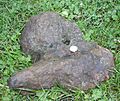Finery forge facts for kids
A finery forge was a special type of hearth (like a big brick fireplace) used long ago to turn pig iron into wrought iron. Pig iron is a bit brittle, but wrought iron is stronger and more useful. People probably started using finery forges around the 3rd century BC. Later, in the 1700s and 1800s, newer methods like the puddling process replaced them.
Contents
How Finery Forges Began
People in China were using finery forges even before 200 BC! In Europe, these forges appeared much later, around 1200 AD. For a long time, Europe's finery forges were not as good as China's. This changed around 1400 AD. Europe then started using water wheels to power their forges. By the 1700s, Europe had also developed blast furnaces and new ways to make iron, like the puddling process.
Different Kinds of Forges
German Forge
In places like Germany and Sweden, many finery forges were quite simple. They usually had only one fire. This single fire was used for all the steps needed to change pig iron into wrought iron.
Walloon Forge
The Walloon finery forges were mainly used in northern Sweden. These forges were famous for making a special type of iron called oregrounds iron. This iron was known to be the best quality iron available in the 1700s.
How Iron Was Made
The process in a finery forge started by melting pig iron. When the pig iron melted, it formed a lump of iron called a bloom. It also created a waste material called slag.
After the iron bloom was formed, it was taken out of the fire. Then, a large hammer would hit the iron lump many times. Hitting the iron with the hammer helped to squeeze out the slag. This made the iron much cleaner and stronger, ready to be used for tools or other items.
Images for kids
-
Hearth (left) and trip hammer (centre) in a finery forge. In the back room (right) is a large pile of charcoal.
-
Interior of the preserved Walloon forge in Österbybruk, Uppland
-
Exterior of the remnants of a Basque forge
See also
 In Spanish: Ferrería para niños
In Spanish: Ferrería para niños





